- History Classics
- Your Profile
- Find History on Facebook (Opens in a new window)
- Find History on Twitter (Opens in a new window)
- Find History on YouTube (Opens in a new window)
- Find History on Instagram (Opens in a new window)
- Find History on TikTok (Opens in a new window)
- This Day In History
- History Podcasts
- History Vault

Printing Press
By: History.com Editors
Updated: April 4, 2024 | Original: May 7, 2018

The printing press is a device that allows for the mass production of uniform printed matter, mainly text in the form of books, pamphlets and newspapers. Created in China, the printing press revolutionized society there before being further developed in Europe in the 15th Century by Johannes Gutenberg and his invention of the Gutenberg press.
When Was the Printing Press Invented?
No one knows when the first printing press was invented or who invented it, but the oldest known printed text originated in China during the first millennium A.D.
The Diamond Sutra , a Buddhist book from Dunhuang, China from around 868 A.D. during the Tang Dynasty , is said to be the oldest known printed book.
The Diamond Sutra was created with a method known as block printing, which utilized panels of hand-carved wood blocks in reverse.
Some other texts have survived from Dunhuang as well, including a printed calendar from around A.D. 877, mathematic charts, a vocabulary guide, etiquette instruction, funeral and wedding guides, children’s educational material, dictionaries and almanacs.
It was during this period of early printing that rolled-up scrolls began to be replaced by book-formatted texts. Woodblock printing was also used in Japan and Korea at the time, and metal block printing was also developed at some point during that period, typically for Buddhist and Taoist texts.
Moveable type, which replaced panels of printing blocks with moveable individual letters that could be reused, was developed by Bi Sheng, from Yingshan, Hubei, China, who lived roughly from 970 to 1051 A.D.
The first moveable type was carved into clay and baked into hard blocks that were then arranged onto an iron frame that was pressed against an iron plate.
The earliest mention of Bi Sheng’s printing press is in the book Dream Pool Essays , written in 1086 by scientist Shen Kuo, who noted that his nephews came into possession of Bi Sheng’s typefaces after his death.
Shen Kuo explained that Bi Sheng did not use wood because the texture is inconsistent and absorbs moisture too easily, and also presents a problem of sticking in the ink. The baked clay cleaned-up better for reuse.
By the time of the Southern Song Dynasty, which ruled from 1127 to 1279 A.D., books had become prevalent in society and helped create a scholarly class of citizens who had the capabilities to become civil servants. Massive printed book collections also became a status symbol for the wealthy class.
Woodtype made a comeback in 1297 when Ching-te magistrate Wang Chen printed a treatise on agriculture and farming practices called Nung Shu .
Wang Chen devised a process to make the wood more durable and precise. He then created a revolving table for typesetters to organize with more efficiency, which led to greater speed in printing.
Nung Shu is considered the world’s first mass-produced book. It was exported to Europe and, coincidentally, documented many Chinese inventions that have been traditionally attributed to Europeans.
Wang Chen’s method of woodblock type continued to be used by printers in China.
Johannes Gutenberg
In Europe, the printing press did not appear until 150 years after Wang Chen’s innovation. Goldsmith and inventor Johannes Gutenberg was a political exile from Mainz, Germany when he began experimenting with printing in Strasbourg (then part of the Holy Roman Empire) in 1440. He returned to Mainz several years later and by 1450, had a printing machine perfected and ready to use commercially: The Gutenberg press.
Gutenberg Press
Integral to Gutenberg’s design was replacing wood with metal and printing blocks with each letter, creating the European version of moveable type.
In order to make the type available in large quantities and to different stages of printing, Gutenberg applied the concept of replica casting, which saw letters created in reverse in brass and then replicas made from these molds by pouring molten lead.
Researchers have speculated that Gutenberg actually used a sand-casting system that uses carved sand to create the metal molds. The letters were fashioned to fit together uniformly to create level lines of letters and consistent columns on flat media.
Gutenberg’s process would not have worked as seamlessly as it did if he had not made his own ink, devised to affix to metal rather than wood. Gutenberg was also able to perfect a method for flattening printing paper for use by using a winepress, traditionally used to press grapes for wine and olives for oil, retrofitted into his printing press design.
Gutenberg Bible
Gutenberg borrowed money from Johannes Fust to fund his project and in 1452, Fust joined Gutenberg as a partner to create books. They set about printing calendars, pamphlets and other ephemera.
In 1452, Gutenberg produced the one book to come out of his shop: a Bible . It’s estimated he printed 180 copies of the 1,300-paged Gutenberg Bible , as many as 60 of them on vellum. Each page of the Bible contained 42 lines of text in Gothic type, with double columns and featuring some letters in color.
For the Bible, Gutenberg used 300 separate molded letter blocks and 50,000 sheets of paper. Many fragments of the books survive. There are 21 complete copies of the Gutenberg Bible, and four complete copies of the vellum version.
Gutenberg’s Later Years
In 1455, Fust foreclosed on Gutenberg. In an ensuing lawsuit, all of Gutenberg’s equipment went to Fust and Peter Schoffer of Gernsheim, Germany, a former calligrapher.
Gutenberg is believed to have continued printing, probably producing an edition of the Catholicon , a Latin dictionary, in 1460. But Gutenberg ceased any efforts at printing after 1460, possibly due to impaired vision. He died in 1468.
Peter Schoffer
Schoffer made use of Gutenberg’s press as soon as it was acquired, and he is considered to be a technically better printer and typographer than Gutenberg. Within two years of seizing Gutenberg’s press, he produced an acclaimed version of The Book of Psalms that featured a three-color title page and varying types within the book.
One notable detail about this edition is the inclusion of a colophon for the very first time in history. A colophon is the section of a book that details publication information. Ten copies of this edition of The Book of Psalms are known to still exist.
Printing Spreads Through Europe
The spread of printing as a trade benefited from workers in Germany who had helped Gutenberg in his early printing experiments and then went on to become printers who taught the trade to others.
After Germany, Italy became the next recipient of Gutenberg’s invention when the printing press was brought to the country in 1465. By 1470, Italian printers began to make a successful trade in printed matter.
German printers were invited to set up presses at the Sorbonne in Paris in 1470, and the librarian there chose books to be printed, mostly textbooks, for the students. By 1476, other German printers had moved to Paris and set up private companies.
Spain welcomed German printers in 1473 in Valencia, spreading to Barcelona in 1475. In 1495, Portugal invited printers to Lisbon.
Gutenberg’s invention was brought to England in 1476 by William Caxton, an Englishman who had lived in Bruges, in what is now Belgium, for years. Caxton went to Cologne to learn to print in 1471 in order to set up a press in Bruges and publish his own translations of various works.
After returning to England, he set up a press in Westminster Abbey , where he worked as a printer for the monarchy until his death in 1491.
Printing Press Changes the World
The worldwide spread of the printing press meant a greater distribution of ideas that threatened the ironclad power structures of Europe.
In 1501, Pope Alexander VI promised excommunication for anyone who printed manuscripts without the church’s approval. Twenty years later, books from John Calvin and Martin Luther spread, bringing into reality what Alexander had feared.
Furthering that threat, Copernicus published his On the Revolutions of Heavenly Spheres , which was seen as heresy by the church.
By 1605, the first official newspaper, Relation , was printed and distributed in Strasbourg. Newspapers appeared all across Europe, formalizing the printing press’ contribution to the growth of literacy, education and the far-reaching availability of uniform information for ordinary people.

HISTORY Vault: 101 Inventions That Changed the World
Take a closer look at the inventions that have transformed our lives far beyond our homes (the steam engine), our planet (the telescope), and our wildest dreams (the Internet).
The Invention of Printing. Theodore Low De Vinne . 500 Years of Printing. S.H. Steinberg . Printer’s Error: An Irreverent History of Books. Rebecca Romney . Science and Civilisation in China: Volume 5, Chemistry and Chemical Technology, Paper and Printing. Joseph Needham, Tsien Tsuen-Hsuin . Cambridge Illustrated History of China. Patricia Buckley Ebrey .

Sign up for Inside History
Get HISTORY’s most fascinating stories delivered to your inbox three times a week.
By submitting your information, you agree to receive emails from HISTORY and A+E Networks. You can opt out at any time. You must be 16 years or older and a resident of the United States.
More details : Privacy Notice | Terms of Use | Contact Us
The Printing Museum galleries and studios are open BY APPOINTMENT ONLY, Tuesday through Friday, 10am - 4pm. .
- Plan a Visit
- Virtual Tour
Group Tours
- Field Trips
Visitor Info
The Printing Museum galleries and studios are open BY APPOINTMENT ONLY, Tuesday through Friday, 10am – 4pm.
Museum Galleries + Store
General admission, guided tours.
During your guided tour, you will learn of early forms of printing, may participate in the hands-on printing of a leaf of the Gutenberg Bible pulled from a replica press, print a copy of the Declaration of Independence on a 19th-century Columbian iron handpress, discover the importance of the Linotype machine, and witness advances in printing and self-publishing that came about in the 20 th century. Your tour concludes with a visit to our book arts studios, and temporary exhibitions (if offered at that time). General Admission is included in the price of a guided tour. Guided tours last about one hour.
Learn more about the Museum Collections and Upcoming Exhibitions .
Guided tours for groups of 8 or more are also available by appointment. Try a Virtual Tour ! For more information, please call 713-522-4652 or email [email protected] .
Our Address:
3121 San Jacinto Street Houston, Texas 77004 (at the intersection of San Jacinto and Elgin streets). (713) 522-4652
Public Transportation:
The Printing Museum is accessible by several METRO Bus Lines:
Check the METRO web site for more information and any changes to these routes. This information is for general use only. The Printing Museum endeavors to keep the information as up-to-date and correct as possible. The Museum cannot accept any liability for errors or omissions or for loss or damage arising from accessing or using the content/information provided.
Accessibility:
The building and facilities are wheelchair accessible.
Photography Policy:
The use of non-flash photography by the general public is permitted in all galleries, unless otherwise indicated. Photographs taken at the The Printing Museum are for personal use only, and are not to be used for commercial purposes. Visitors must receive permission by Museum staff to use tri-pods. Video is not allowed without prior permission.
Dining Options:
Several dining options, some within a comfortable walk from the Museum, are available .
Holiday Calendar:
The Museum is closed on the following holidays:
- New Year’s Day
- Martin Luther King, Jr. Day
- Memorial Day
- Independence Day
- Thanksgiving: Thursday & Friday
- Christmas Day
Museum Hours
BY APPOINTMENT TUES - FRI: 10am-4pm
The Museum is closed every Monday and Sunday.
Become a Member
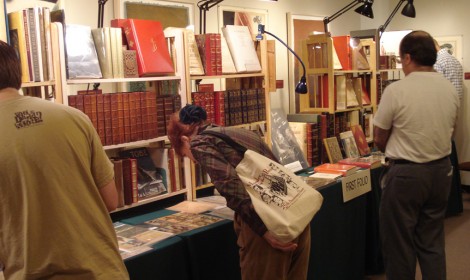
- Skip to primary navigation
- Skip to main content
- Skip to footer
South Street Seaport Museum
Where New York Begins
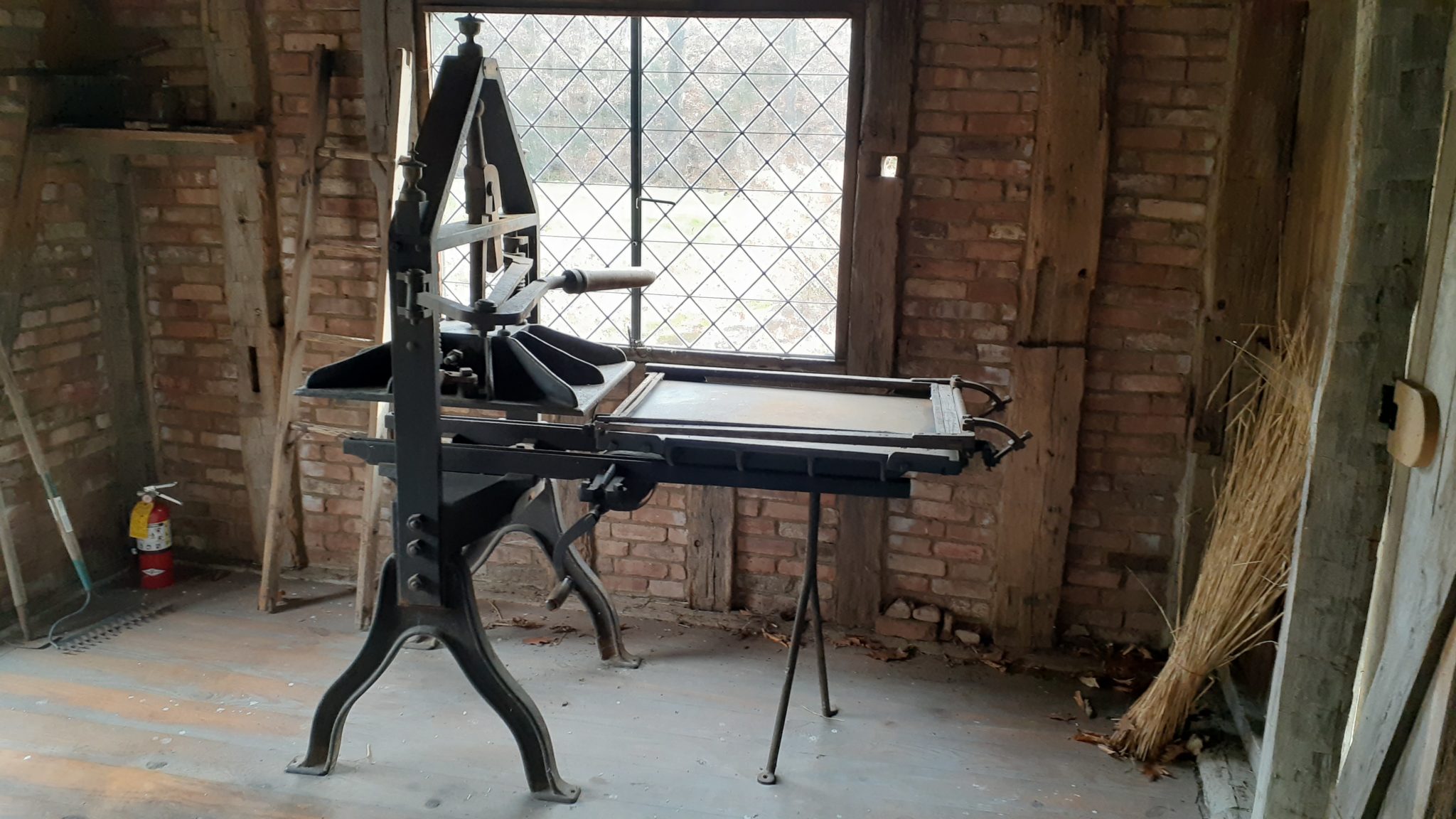
One Printing Press and Three Museums
Deaccessioning as an essential part of museum practice.
A Collections Chronicles Blog by Martina Caruso, Director of Collections and Rob Wilson, Art Director and Operations Manager, Bowne & Co. June 10, 2021
The story we’re about to tell you came out of the process of inventory, research, and investigation of the history of collecting items related to printing history, often displayed, interpreted and used at Bowne & Co. It follows the life of one printing press and its connection to three different museums on two coasts. When we thought of telling a larger audience about this adventure we had a few points that we wanted to highlight: first, how impactful long-term loans can be; second, how important and healthy it is to refine a collection; and third, how critical it is to build a network of peers and professionals in our field(s).
The South Street Seaport Museum as a whole celebrates the community and economy that grew up around the port of New York. Throughout the 19th century, every business and transaction needed receipts, bills, advertisements, and certificates; printing offices like the historic Bowne & Co. filled that need. The Seaport Museum holds over 28,000 artifacts composed of a wide variety of mediums and topics, including a printing history collection built around a working variety of printing presses, as well as a vast holding of printing equipment, printing types, photo-engravings, and hand-cut wood blocks. This collection preserves the tradition of small-batch job printing in the 19th century, while keeping an open and active dialogue with contemporary practices of printmaking and graphic design communities.
Since 1975, Bowne & Co. have taken responsibility for holding artifacts and equipment in the public trust on behalf of the Seaport Museum. The nature of most items in this collection, particularly the printing presses, requires that they be operated by trained staff in order to better preserve them, and the staff at Bowne & Co. care for the working printing equipment in collaboration with the Museum’s Collections Department. These objects are considered part of the “Working Collections” of the Museum, used and put in action on a daily basis by trained staff members for the artifacts’ own preservation, and the preservation of the related traditional skills.
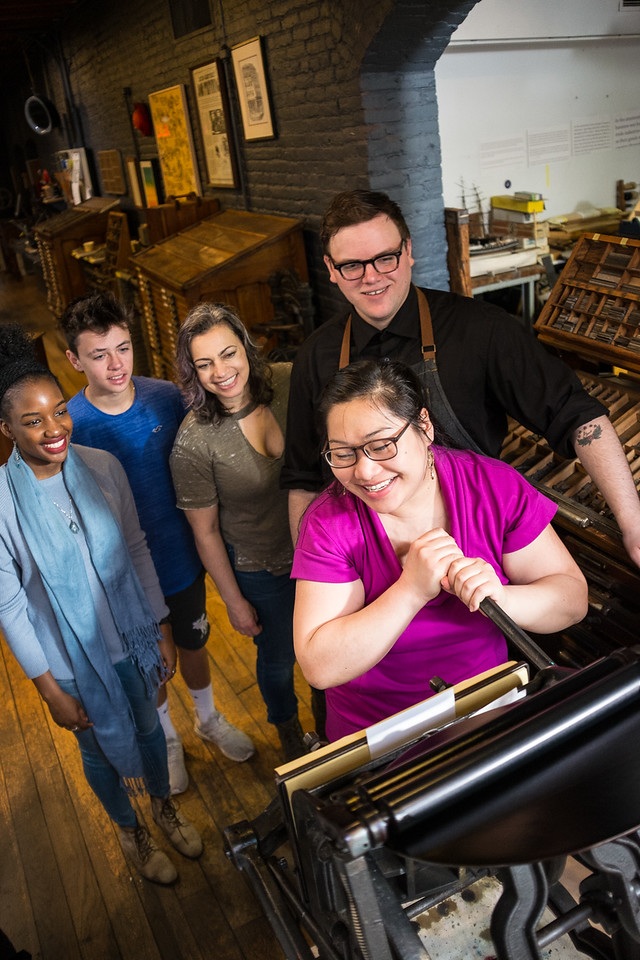
As part of the first wall-to-wall inventory of the Museum’s collections in over two decades, a full catalog of accessioned printing presses and printing equipment has been ongoing since the fall of 2015. The process includes looking at the equipment in the print shops, photographing them and assessing their condition, as well matching objects with their acquisition documentation, provenance, exhibition, publication, and loan history. Through this process we uncovered many old incoming and outgoing loans that provided us with a full picture of the curatorial scope of our entire collection.
Objects come into a museum’s collections because they are determined to have value—cultural value, artistic value, or educational value that gives us special understanding of the past. For the Seaport Museum, the origins and growth of New York City as a world port is integral to our mission. However, sometimes objects that were added to the collection are found to fall outside of our mission and have little New York City significance or storytelling value. The process of reviewing and removing items from a museum’s collection is known as deaccessioning. A healthy and necessary practice, deaccessioning allows museums to better care for the collections that best reflect their mission, to reduce duplicate items, and to better maintain safe environments for the collections that remain.
Bronstrup Philadelphia Iron Hand Press
The star of this deaccession adventure is a Bronstrup Philadelphia handpress, which represents a great technological shift in printing technology, moving away from presses made from wood, to presses made from iron. While iron presses were vastly heavier than their wooden counterparts, they were also much stronger, and allowed for bigger printable areas, and faster operation. The 1820s saw many competing patents for presses that sought to find balance between strength, simplicity, and ease of use. In the United States, the most popular style of iron hand press was the Washington, invented by Samuel Rust in 1821. The Washington Press became the favorite of many printers of the time due to the strength of the toggle mechanism, which produced a large mechanical advantage in a relatively simple and compact package.
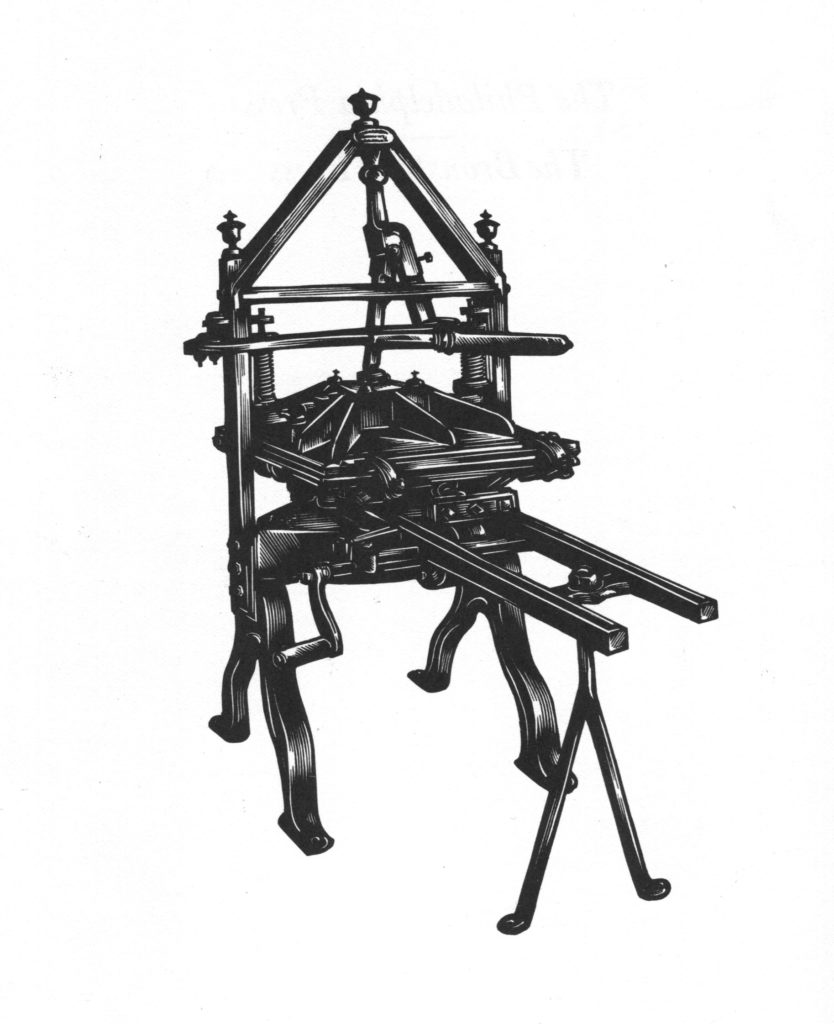
The Bronstrup Philadelphia Press is a press with two names. Initially designed by Adam Ramage as the Philadelphia Press in 1833 or 1834, the press was designed as a wrought iron construction, rather than the popular cast iron as seen in the Washington. This allowed the press to retain its strength, while drastically reducing weight. This weight reduction saw the Philadelphia press rise in popularity with printing outfits setting up in western states.
Adam Ramage was succeeded by Frederick Bronstrup upon his death in 1850. Bronstrup made small changes to the Philadelphia press, mainly in modifying the toggle mechanism to more closely resemble that of the Washington Presses. This new press was sold as the Bronstrup Press until 1875.
Bronstrup Philadelphia Hand Press engraving by Jon DePol (1913-2004), published in “American Iron Handpresses” by Stephen O. Saxe, Oak Knoll Books, 1992.
This press was on view at Bowne & Co. between 1975 and 1982, and after only 7 years on-site it started its “career” as a representative of the Museum in two other cultural institutions.
Outgoing Loan History
The Bronstrup was on loan to the Fairleigh-Dickinson University, in Teaneck, New Jersey, from 1982-1999, and since 1999 it has been on loan to the Gomez Mill House, in Marlboro, New York.
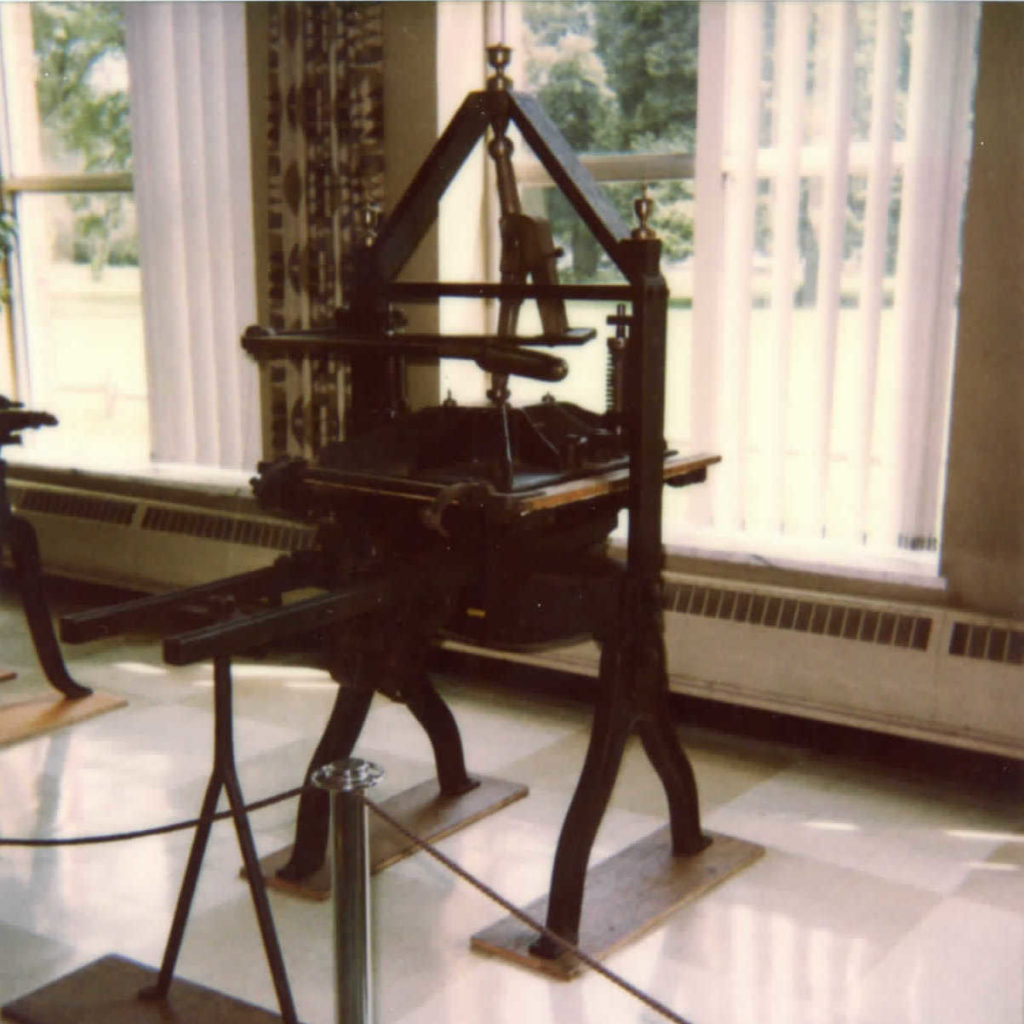
Left: Bronstrup Press at Fairleigh-Dickinson University, 1982. Right: Bronstrup Press at the Gomez Mill House, 2018.
In the past, one of the key ways that the Seaport Museum allowed the public to access the collection around the United States, and particularly the East Coast, was through long-term loans. However, in recent years, long-term loans have been paused for a variety of reasons including but not limited to the fact that a number of states have passed old loan legislation in reaction to problems that arise where loans are left in museums for indefinite or long periods of time. Such problems include the amount of administrative work needed to properly manage the relationship and the required paperwork, the increasing opportunity of being “lost in translation” between staffing changes and the lender’s personal situation, and the confusion and misunderstanding that such objects could create if stored with collections items belonging to the borrowing institution.
Gomez Mill House
The Gomez Mill House in Marlboro, New York, in the central Hudson Valley, has a fascinating history, and it is thought to be the oldest Jewish residence still standing in the United States. Luis Moses (or Moises) Gomez bought the land that surrounded the house in 1714, but it’s unlikely that Mr. Gomez lived there, although it is likely that at least some of his four sons did, at least sporadically. He was the son of an influential Spaniard, Isaac Gomez, a wealthy man so well-positioned that he advised the King of Spain. He was educated in London, and then the family moved to the Caribbean—there is firm evidence of Gomezes in Jamaica—and he might have lived on other islands as well. Jamaica flourished as a commercial center until 1692, when a tremendous earthquake demolished its main city, Port Royal. So in 1700, Luis Moses Gomez and his wife, Esther, moved to the fast-growing financial center of New York, Lower Manhattan, and to be precise, Maiden Lane, just south of the seaport.
Gomez was a trader and an entrepreneur. He built the Mill House as an outpost, a place to stay as he and his sons oversaw the trade in timber and limestone, commodities available in profusion upstate. When the Gomez family began doing business in the central Hudson Valley, there was no Jewish community there, and wouldn’t be until more than a century later. After Gomez, the house had many owners, some of them notable.

From 1772 to 1799, the house was owned by Wolfert Ecker (1730-1799), descended from a prominent Dutch family that arrived in New Netherlands in 1655. Ecker was a Revolution-era patriot, and he set up a local committee for safety and inspection that, according to Gomez Mill’s director, Richie Rosencrans, was one of the tools that local leaders established—a form of ad-hoc government to keep society’s basic rules in place once the British began to lose power but before formal local, state, or federal government agencies could take over.
Next—after some gaps—came the artistic and civic-minded Armstrong family, landed gentry who lived in the Gomez Mill House from 1835 to 1904. Among the various generations of the family, David Maitland Armstrong (1836-1918) was particularly interesting. He was a diplomat, a painter, and a renowned stained glass artist, whose works are still visible in the house. Maitland was largely responsible for creating the Metropolitan Museum of Art, which opened on February 20, 1872. In his obituary, the New-York Tribune stated: “Not only did he, in company with Robert Gordon and Dr. Nevin, first start the agitation for a representative museum in this city, but he also drafted suggestions for the carrying out of the project, with the result that the Metropolitan Museum as it exists to-day is largely organized on the lines he laid out.”

Another gap, and then there was William Joseph “Dard” Hunter (1883-1966), whose tenure was short, from 1912 to 1918, but had many intriguing connections with our Museum’s mission and collection. Dard was a printer, bookbinder, and a paper craftsman. In 1913, he built a paper mill adjacent to the pond and dam across the road from the main house, fashioned after 17th-century Devonshire cottages. Until then all the world’s handmade books were made by different masters in sequence—papermakers, typographers, printers—working separately with apprentices. Dard’s creations were the world’s first handmade books designed and constructed by one person, and his success inspired other Americans to begin producing handmade paper again.
Lastly, from 1918 to 1925, the house was owned by Martha Gruening (1889-1937), an American journalist, lawyer, and Civil Rights activist. With her, there was a bit of full-circle completion to her residency; like the Gomezes, Ms. Gruening and her family were Jewish.
Deaccessioning
In 2019, as part of the refinement of our printing history collection, we took a hard look at our collection of working printing presses, and when in 2020 the Gomez Mill House decided to end the loan, we had to make some decisions.
Over the past year or two, the debates, discussions, symposiums, and news about deaccessioning in museums flourished, but many misunderstandings about deaccessioning and museum collections remain both within and beyond the United States.
Here at the Seaport Museum we have been doing our part. We studied and analyzed some of the original and essential purposes of the deaccessioning process in museums, as well as looked at the process by which it has become—in some cases—a suspect practice. Among the many resources, webinars, and conversations we investigated is the recently published book by California museum consultant Martin Gammon, Deaccessioning and Its Discontents , which provided us with some wonderful guidance. One of the main findings of the publication is that deaccessioning has been an essential part of museum practice since the dawn of the museum experiment in the 17th century, and as curators manage the accumulation of multiple private collections into a growing public collection, they often come to realize the need to deaccession in order to refine the collection over time to ensure it has ongoing coherence and is improving through the evolution of each institution.
Deaccessioning has gotten a bad reputation only in the last three decades of the 20th century because of the significant pressure on leading museums to deaccession works in order to simply stay solvent and afloat—these pressures including decreased government funding, a detrimental U.S. tax reform act, and a booming art market. This burden has resulted in a situation where museums are more financially pressured than ever to sell off works for the wrong reasons—even though both the American Alliance of Museums and the Association of Art Museum Directors say that selling off artworks is only acceptable when the proceeds are used toward new acquisitions, not operating expenses, salaries, or capital projects.
The Seaport Museum chooses to deaccession objects for a few reasons. An item might not fit our mission or collections plan. Items with unknown provenance or otherwise lacking in historical value or usefulness are also candidates for deaccession. Poor condition or duplication are other reasons.
Since 2015, when we were both hired, we have approached both acquisitions and accessioning, as well as disposal and deaccessioning, in practical terms. We both believe deaccessioning is a fundamental business practice necessary for the responsible preservation and health of our collections.
Assessing candidates for deaccession is a slow and deliberate process. We have set guidelines for careful selection, which involves gathering all the information known about the item and then making a recommendation. The information and recommendations are reviewed and approved by a Staff Collections Committee, then by the Museum’s Board of Trustees, and, overall, guided by state statute. Depending on the condition of the deaccessioned piece, it may be transferred to another educational institution, exchanged, destroyed, or sold at public auction. The proceeds are restricted and can only be used to obtain new collections items or for direct care of collections. Going through a deaccessioning process allows us to complete targeted research on the collection, often increasing our knowledge about the objects we hold.
The Bronstrup was the third similar type of press after the R. Hoe Washington Hand Press, on view and used for demonstrations at Bowne & Co. at 207-209 Water Street, and the Cincinnati Washington Hand Press that we were also considering deaccessioning for redundancy reasons. As part of the refinement of the Museum’s printing history collection, the Bronstrup was then deemed not to be essential to tell the history of Bowne & Co. and printing in New York, due to her manufacturer and limited history at the Museum. So, after having her deaccession approved by the Collection Committee, we started to look for a new home for it.
International Printing Museum
Much of this story was made possible by a visit to Bowne & Co. from Mark Barbour of the International Printing Museum in Carson, California. The letterpress community is mighty but small, and smaller yet is the printing museum community. In early April of 2021, Mark happened to be on a trip to New York to install a press for a film shoot. The South Street Seaport Museum and the International Printing Museum have had an open dialogue for many years, but being on opposite coasts, it’s a rare treat to be able to physically visit each other’s collections. Mark had not visited Bowne & Co. for at least a decade, and a lot had moved around the Museum in that time. It was a great opportunity to reorient both the collections and mission of the Seaport Museum with a similar institution.

Part of what came out of his visit was a deeper understanding of where the missions of both museums cross over, and where they differ. The South Street Seaport Museum’s mission is fundamentally rooted in telling the story of the rise of New York as a port city. Printing plays a huge role in that story, but its role is in the service that printing offices offered to the financial growth of the city, and the technology that supported that rapid growth. The mission of the Seaport Museum is not to encapsulate the minutiae of technological development amongst similar printing equipment.
The Bronstrup is much better suited in the collection of the International Printing Museum—a collection which covers the incremental advancements in printing technology made throughout history. Transferring the Bronstrup from the Gomez Mill House to the International Printing Museum both helped the Seaport Museum refine its collection to best express its mission and increased the breadth of the collection at the International Printing Museum. We are thrilled that this press found such a good home, and we look forward to working together in the future.
Inventorying, reexamining old loans, and refining the collection can be a long, but rewarding process. Not only do staff rediscover lost collection items, they can also uncover lost stories that help us better understand the people who’ve lived and worked in the port of New York over the centuries. Removing an item that no longer supports the Museum’s mission leaves more collection care resources, storage space, and conservation budget for those pieces that still have research and education potential. When a collections item can better tell its story at another institution, like the Bronstrup Philadelphia Hand Press with our friends at the International Printing Museum, deaccessioning is especially rewarding.
Additional readings and resources :
American Alliance of Museums Code of Ethics
“Typographia, 3rd Edition” by Thomas F. Adams, Philadelphia 1845, p.272.
“ The Cultural Logic of the Late Capitalist Museum ” by Rosalind Krauss, The MIT Press, October, Vol. 54 (Autumn, 1990), pp. 3-17.
“American Iron Handpresses” by Stephen O. Saxe, Oak Knoll Books, 1992.
“ Printing on the Iron Handpress ” by Richard-Gabriel Rummonds, Oak Knoll Press & The British Library, 1998.
“Things Great and Small: Collections Management Policies” by John E. Simmons, American Association of Museums, 2006.
“Managing Previously Unmanaged Collections: A Practical Guide for Museums” by Angela Kipp, Rowman & Littlefield, 2016.
“ Collection Ranking: Making deaccessions work for you ” by Caitlin Podas, posted on October 23, 2019 on American Alliance of Museum Blog.
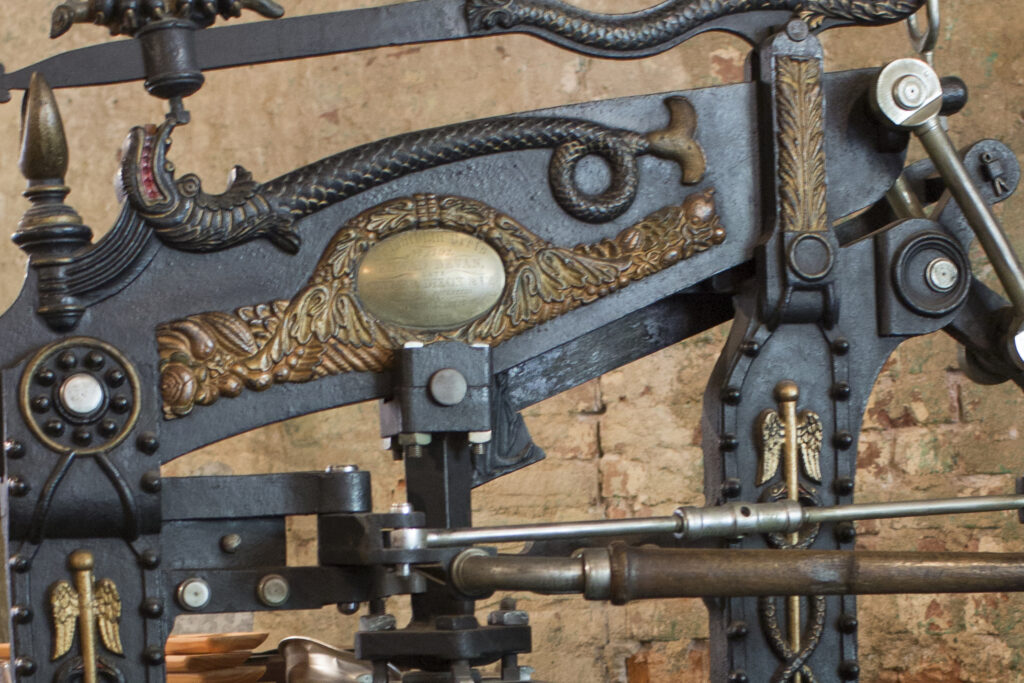
Bowne & Co.
Bowne & Co. is New York’s oldest operating business under the same name. Using seven historic presses from the Museum’s working collection, our resident printers continue the age-old tradition of job (or small batch) printing, creating individual designs using custom plates or historic fonts.
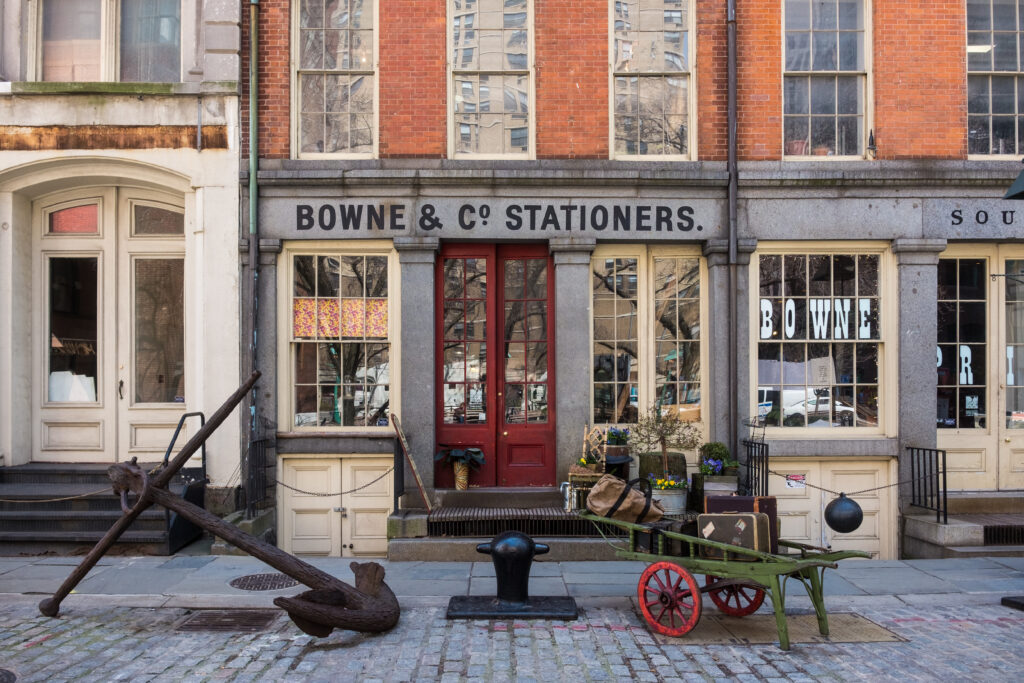
Visit Our Online Shop
We’re excited to announce our new Bowne & Co. Online Shop with a special selection of core offerings from Bowne & Co.
References [ + ]
12 Fulton Street NY, NY 10038 (212) 748-8600 Open: Wednesday–Sunday, 11am–5pm
#SouthStreetSeaportMuseum #WhereNewYorkBegins
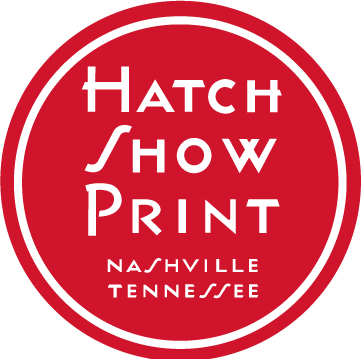
Plan Your Visit
Everything you need to know to plan your visit to Hatch Show Print.
Monday - Sunday: 9:00 AM – 5:30 PM Phone: (615) 577-7710
Haley Gallery
Monday - Sunday: 9:30 AM – 5:30 PM Phone: (615) 577-7711 Email: [email protected]
Monday - Friday: 9:00 AM – 5:00 PM Phone: 615-256-2805 Fax: (615) 254-5202 Email: [email protected]
Come Visit - We Can't Wait to See You
You can find Hatch Show Print in the Rep. John Lewis Way lobby of the Country Music Hall of Fame and Museum building. If you enter the Museum on Demonbreun, take the hall to the right of the Information Desk, right between the Museum’s two shops, down to our lobby. If you are on Rep. John Lewis Way South, look for the neon sign, about halfway between Demonbreun and Korean Veterans Boulevard.
Tours and Programs
The Hatch Show Print tour is a sensory and educational experience on moveable type, letterpress printing and Nashville’s story as Music City.
Take the tour of Hatch Show Print and learn all about the history of this iconic letterpress poster shop. Listen to the presses run. See the century-and-a-half’s worth of brilliantly colored posters printed for your favorite entertainers. Smell the ink. Handle the tools of the trade to print your own keepsake poster in our print shop-within-a-print shop Universal Music Group Space for Design.
Public Tours
Tours take place daily between 10 am and 4 pm, and last approximately one hour.
Check availability and book a tour now.
Or call (615) 416-2001.
We are closed on Thanksgiving, Christmas Eve, and Christmas Day.
Group Tours
Are you interested in booking a tour for a group – coworkers, colleagues, or fellow travelers? Or are you a tour operator interested in offering the Hatch Show Print Tour to your clients? We offer private group tours at special times of the day for groups of 15 or more.
Other Activities and Events
Check our Calendar to find out about other activities, events and programs we’ve scheduled during your visit.
We use cookies in the following ways: (1) for system administration, (2) to assess the performance of the website, (3) to personalize your experience, content and ads, (4) to provide social media features, and (5) to analyze our traffic. You consent to our cookies if you continue to use our website. Please consult instructions for your web browser to disable or block cookies, or to receive a warning before a cookie is stored on your computer or mobile device. Read our Privacy Policy .

- 5 star hotels in Riyadh
- 5 star hotels in Jeddah
- 5 star hotels in Makkah
- 5 Star hotels in Madinah
- 5 star hotels in Abha
- Hotels in Dammam
- Hotels in Al Khobar
- Hotels in Taif
- Hotels in Jubail
- Hotels in Yanbu
- Hotels in Al Ula
- Hotels in Tabuk
- Hotels in King Abdullah Economic City
- Hotels in Hail
- Hotels in Jazan
- All Restaurants
- Indian Restaurants in Riyadh
- Italian Restaurants in Riyadh
- French Restaurants in Riyadh
- Chinese Restaurants in Riyadh
- Japanese Restaurants in Riyadh
- Cafes in Riyadh
- Korean Restaurants in Riyadh
- Turkish Restaurants in Riyadh
- Pakistani Restaurants in Riyadh
- Lebanese Restaurants in Riyadh
- Seafood Restaurants in Riyadh
- Steakhouses in Riyadh
- Thai Restaurants in Riyadh
- Mexican Restaurants in Riyadh
- Breakfast Restaurants in Riyadh
- Restaurants in Bujairi Terrace
- Restaurants in VIA Riyadh
- Restaurants in KAFD
- Cafes in Jeddah
- Korean Restaurants in Jeddah
- Indian Restaurants in Jeddah
- Italian Restaurants in Jeddah
- Chinese Restaurants in Jeddah
- Japanese Restaurants in Jeddah
- Turkish Restaurants in Jeddah
- Seafood Restaurants in Jeddah
- Lebanese Restaurants in Jeddah
- Asian Restaurants in Jeddah
- Thai Restaurants in Jeddah
- Restaurants in Jeddah Yacht Club
- Indian Restaurants in Khobar
- Italian Restaurants in Khobar
- Japanese Restaurants in Khobar
- Seafood Restaurants in Khobar
- Cafes in Khobar
- Chinese Restaurants in Khobar
- Turkish Restaurants in Khobar
- Restaurants in Dammam
- Restaurants in Makkah
- Restaurants in Madinah
- Restaurants in Taif
- Restaurants in AlUla
- All Destinations
- Places to visit in Riyadh
- Places to Visit in Diriyah
- Places to visit in Jeddah
- Places to visit in Makkah
- Places to visit in Madinah
- Places to Visit in NEOM
- Places To Visit in The RED SEA
- Places to visit in Abha
- Places to Visit in AlUla
- Places to visit in Dammam
- Places to visit in Khobar
- Places to visit in Taif
- Places to visit in Jubail
- Places to visit in Tabuk
- Places to visit in Al Baha
- Places to visit in Hail
- Places to visit in Yanbu
- All Flights
- Riyadh to Abha flight
- Riyadh to Dammam flight
- Riyadh to Jeddah flight
- Riyadh to Madinah flight
- Riyadh to Tabuk flight
- Jeddah to Abha flight
- Jeddah to Dammam flight
- Jeddah to Riyadh flight
- Jeddah to Tabuk flight
- Madinah to Dammam flight
- Madinah to Riyadh flight
- Abha to Dammam flight
- Abha to Jeddah flight
- Abha to Riyadh flight
- Dammam to Abha flight
- Dammam to Jeddah flight
- Dammam to Madinah flight
- Dammam to Riyadh flight
- Delhi to Dammam flight
- Delhi to Jeddah flight
- Dubai to Dammam flight
- Hyderabad to Dammam flight
- Manila to Riyadh flight
- Mumbai to Dammam flight
- Claim Your Restaurant Page
- Pricing Plans
- Latest News
- Login Sign Up
- Restaurants
- Destinations
King Fahd Glorious Quran Printing Complex - Madinah
Description.
King Fahd Glorious Quran Printing Complex is a printing press in Medina. This complex exclusively prints more than 10 million copies of the Holy Quran every year. These prints are not just in the Arabic language but also include translations in languages such as English, Indonesian, Russian, Japanese, Persian, Urdu, Bengali, Korean and many more. The size of the Quran copies available in the complex range from pocket-size to much bigger ones.
Printing Mechanism
The complex prints the most authentic Quran copies that are distributed all over the world. The Quran is no ordinary book, and its printing is also very much different from that of any other book as it is highly sacred in Islam. The staff working at the press consists of experts that check the prints word by word to make sure there are no typing errors, ensuring there is not even a single word misprinted.
Visiting the Complex
The Holy Book cannot be touched without wudhu (ablution) which is why visitors can only view the printing process from above. The complex has different types of Qurans displayed in glass cases. While leaving the complex, a copy of the Holy book is also gifted to visitors. Everyone receives a small Quran apart from older people who are given bigger copies.
Certain areas of the facility have restrictions that do not allow women to visit. Admission of visitors is restricted so it is better to get permission and make arrangements beforehand. People interested in visiting the complex should plan an early trip as long queues begin to form with time. It is a good educational trip for those who are interested in the printing of the Quran and the mechanics that happen behind the scenes.
Destination Type
Nearby tourist sites, hotels nearby, nearby restaurants, sadafat seafood restaurant - madinah, rusafa arabic lebanese middle eastern restaurant- madinah, qurnfel lebanese restaurant - madinah - مطعم قرنفل, dose cafe and breakfast lounge - madinah, la manana restaurant and cafe - madinah, pie street - madinah, tgi friday's american restaurant - madinah, davanti lounge - دافانتي لاونج, customer photos and videos.
- Travel tips
Soban Sajid
Google review
haytham ABDELWAHAB
Md. Mamunur Rashid (MAMUN)
Qadir Haroon
Bayazid Yaqub Durbar
Ahmed kasem 1 questions, rully agustine 1 questions, stay in touch.
Stay up to date with our latest news and products.
- Privacy Policy
© Copyright 2024 Welcome Saudi. All rights reserved. Various trademarks held by their respective owners.
All fields are required unless specified optional
Restore password
Congratulations.
Welcome Saudi website requires cookies to provide all of its features. By using our website, you agree to our terms of use and cookie policy. More info
- Commercial Printing | Professional Printing & Business Printing Services - U.S. Press
New customer? Get 10% off your first order by subscribing to our mailing list

Real Humans, Real Service 800-227-7377
Cart is empty..

Commercial Printing Services
The commercial printing company trusted by thousands of businesses across America. U.S. Press is your partner for high-quality printing solutions with first-class service.
All customers are given a personal point of contact to make the order process a breeze.
Customize your business printing using our easy online design tool available on most of our products.
Use our pricing calculators to generate instant prices on your commercial printing projects.
With 42 years of experience, we guarantee high-quality professional printing on every order.
Featured Commercial Printing Products
Commercial Printing & Direct Mail Services
Save time and money by combining your commercial printing with direct mail services by U.S. Press. We offer custom direct mailing services for postcards , brochures , catalogs , and more. Quickly create professional advertising printing and vibrant mailing materials to separate your business or campaign from the competition.


Choose A Trusted Commercial Printing Company, U.S. Press
Choosing a commercial printing company to market your business can be a difficult task. Many budget online companies don't provide personalized customer service and lack the attention to detail needed for professional printing. High-quality business printing services can be frequently confusing and unaffordable. U.S. Press offers the best of both worlds to become the commercial printing company of your dreams. We make your advertising printing choice easy by offering:
- High Quality Commercial Printing - With over 42 years of experience, we're the experts in print marketing. Request a free sample kit to see the difference in our professional printing.
- Convenience - We make online business printing easy. You'll have gorgeous results with just a few clicks.
- Online Design Tools - Upload your own file, use one of our templates or create a new design online. We also have online resources for all your commercial printing needs.
- Personalized Customer Service - Each customer receives their own dedicated account rep to assist with each and every order.
- Transparent Pricing - You'll know the cost of your project up front, so there isn't any sticker shock. We also offer bulk printing discounts for larger orders.
We offer instant pricing when you request a commercial printing quote, so you'll know exactly how much your stationery, sticker, banner and brochure printing solutions will cost. In addition, once you place your business printing order, you'll be assigned a personal point of contact for any questions or concerns you may have.
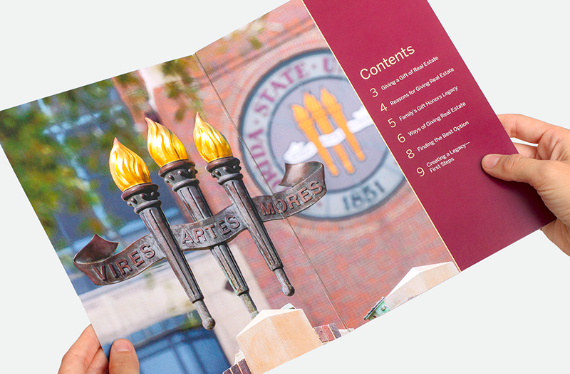
Industry Trusted Commercial Printing Services
Different industries have their own unique needs for business printing services. That's why U.S. Press offers promotional material printing geared to your specific business or organization. From distinct design templates to industry-specific products, professional printing has never been easier. Whether you need attractions and tourism printing for an amusement park or promotional printing for your church , we ensure that your order is done on time.
And with a personal printing solutions point of contact to assist you with all your orders, we're here to make promoting your organization with full color promotional material printing as easy as possible.
Shop U.S. Press For All Your Commercial Printing Needs
Whether you're a small organization or a Fortune 500 company, we know the importance of having a trusted source for your print marketing needs. At U.S. Press, it's our goal to be your dedicated source for all of your business printing services.
As an experienced commercial printing company, we know that it's essential to have custom printing solutions like banners and signs that attract customers. We apply those same qualities to our work as a brochure printing company, as well. Professionally printed brochures, flyers, restaurant menus and other bulk printing products help you tell your story and make sales.
Our catalog printing services are unparalleled in the industry. We are here for both your short-run and large-scale professional printing needs. Choose from saddle stitch booklets or perfect bound books for superior promotional material printing results.
Our business printing services don't stop there: we offer complete direct mail services and fulfillment to give you the convenience of one-stop shopping for all your advertising printing orders.
From full-color offset printing to short-run digital printing, you can count on our commercial printing services to make you stand out and get your message across beautifully. Business printing from U.S. Press offers cost-effective and efficient solutions to handle your project professionally and fast. Get your custom quote today!
You've just added this product to the cart:
Xerox Digital Printing Press Portfolio
We offer the broadest digital printing press portfolio of cut-sheet digital presses and production printers on the market. Sheet-fed digital printing presses are ideal for graphic communications and commercial print providers' high-speed, high-volume printing applications, including publishing, transaction printing, direct mail, packaging and photo publishing.
Benefits of Digital Printing
Sheet-fed digital printing presses are ideal for graphic communications and commercial print providers' high-speed, high-volume printing applications. Make prints using digital files in PDF, JPEG, BMP or other formats and get high resolution images in fine detail. Digital printing presses deliver the high-value applications your customers expect. This is what a digital printing press offers:
- High Quality. Whether you’re producing a brochure, flyer or booklet, expect consistent printing across the board with a digital printing press. Some of our digital presses offer ultra-high definition resolution with four times more pixels than standard for stunning, vibrant colors on a range of media.
- Speed. Depending on the model, our production printers can deliver 75 to 314 pages per minute.
- Customization. Digital printing is ideal for customized marketing materials, photographs and other applications. Boost color management, apply specialty enhancements or complete your output with a variety of inline finishing options for unparalleled results.
- Automation. Many brands in our digital printing press line have built-in, advanced automation features from Xerox innovation to transform performance and contribute to your bottom line.
Shop the Xerox cutting-edge digital printing press collection today.
Xerox ® Iridesse ® Production Press
Print like a pro in seconds. end-to-end automation nails the basics. inline speciality embellishment options add profit-driving “wow.”.
- Up to six inline print stations that print in a single pass, at rated speed, with spot on color-to-color registration
- Optional White, Clear, Silver, Gold, and gamut extension Fluorescent Pink Specialty Dry Inks for enhancements and brand color matching, plus Media Expansion Low Gloss Clear
- AI-guided Xerox ® PredictPrint Media Manager Software baselines the press, expediting time to production
- Optimize performance with mixed-stock jobs supported by the Xerox ® Mixed Media Acceleration Feature
- Additional high capacity feeders and inline finishing solutions, including robust configurations that accelerate XLS sheet productivity end-to-end
Xerox Versant 280 Press
The all-in-one, ever-evolving, field-proven profit builder. reimagined to deliver everything you need in a mid-production press..
- All Stocks Rated Speed (ASRS) option to print 25% faster on every stock up to 400 gsm
- Take automation to the extreme with click-simple automated color quality with an inline Spectrophotometer and ASRS speed with the Performance Package (PP) option
- Bigger is better with production printing of up to 47” / 1.2m sheet in Ultra HD
- Get noticed with the Xerox ® Adaptive CMYK+ Kit: Vivid and Fluorescent Specialty Toners add gold, silver, white, clear, or fluorescent cyan, fluorescent magenta and fluorescent yellow to your applications
Xerox Versant 4100 Press
A versatile press reinvented with even more smart automation for virtually touch-free quality control.
- Simplify and automate time-consuming tasks like image-to-media alignment, density, uniformity, color calibration and profiling with our Full Width Array (FWA)
- Print high-quality output with Xerox ® EA Toner for incredible 2400 x 2400 dpi Ultra HD Resolution and 10-bit RIP rendering
- Versatile feeding up to 47” / 1.2 m sheets and Finishing options for creating exactly the Versant press you need to build your business
- Xerox ® PredictPrint Media Manager provides powerful, cloud-based stock management
Xerox iGen 5 Press
Be ingenious with advanced automation, an optional 5th print station, and extra-long sheet capabilities up to 35"/889 mm..
- Quality and productivity are guaranteed with advanced automation to print more with less cost and effort.
- 5th print station supports the Orange, Green, and Blue Gamut Extension colors as well as White, Clear, and Fluorescent Yellow Dry Inks to create differentiation with high-value digital print enhancements.
- 26"/660 mm or optional 35"/889 mm extra-long sheet (XLS) sizes help you expand into new markets, bigger applications, and unlock the potential to boost productivity on certain jobs up to 25% with the XLS imposition advantage.
- Press design delivers built-in investment protection with ultimate configuration flexibility that precisely matches your current and future needs.
Xerox ® Baltoro ® HF Inkjet Press
Inkonomics amplified.
- Enables new application opportunities on a range of offset coated media including gloss, with the optional Color Accelerator Module with High Fusion Ink
- Best-in-class total cost of ownership powered by Automated Intelligence
- High Fusion print engine with Xerox High Fusion W-Series Inkjet Heads provides true high definition 1200 x 1200 dpi resolution
- Modular, scalable platform for maximum investment protection
Xerox Nuvera 120/144/157 Presses
Stunning image quality.
- 15 different ways to finish output inline or near-line
- 44 gsm to 300 gsm
- Up to 23,200 sheet feed capacity, load while run
Xerox Nuvera 288/314 Presses
The formula for perfect productivity, xerox primelink c9065/c9070 color printer, breakthrough performance. new business results..
- Color MFP with support for 13 x 26 in. (330 x 660mm) banner printing
- Flexible, production-ready finishing and feeding with a range of Digital Front Ends to fit every print environment
- Exceptional reliability and image quality with built-in security and workflow apps
- Get noticed with Xerox ® CMYK Plus Technology: Vivid and Fluorescent Specialty Toners add gold, silver, white, clear, or fluorescent cyan, fluorescent magenta and fluorescent yellow to your applications
Xerox PrimeLink B9100 Series Copier/Printer
Production ready, office-friendly black and white..
- B&W MFP with support for 13 x 26 in. (330 x 660mm) banner printing
- Walk-up simplicity and production-level capability in one compact device
- Incredibly reliable with exceptional image quality
- Endlessly configurable – feeding, finishing, and Digital Front End options to fit every print environment
- A wealth of production-friendly, office-ready features including workflow apps and built-in security
Xerox ED95A/ED125
The xerox ed95a/ed125 copier/printer is also available for sale as the xerox d95a/d125 pro copier/printer.
- Black-and-white Copier/Printer with support for 13 x 19.2 in. / SRA3
- Factory produced new model, designed for sustainability
- Copy, print, scan, email
- Xerox ® EX II Print Server delivers hyper-performance with outstanding image quality - getting more work done, faster
- Consistent, high-quality reproduction of text, solids, photos and graphics, with exceptional registration for polished, professional results
- Not available in all geographic locations — Please contact your Xerox Sales Rep for more information
Xerox Color EC70
The xerox color ec70 printer is also available for sale as the xerox color c60/c70 pro printer.
- Color MFP with support for 13 x 19.2 in. / SRA3
- Copy, print, scan, email, optional fax
- Best for high end departmental, graphic communications, and quick, franchise or in-plant printers
- Enter the Beyond CMYK digital print market with Adaptive CMYK+ Vivid Kit: glimmering gold, sparkling silver, clear, and bright white toner
- Office Printers (30)
- Xerox Multifunction / All-in-One Laser Printers (24)
- Xerox Digital Printing Press Portfolio (11)
Color Capability
- Black and White (4)
Maximum Paper Sizes
- 12.6x19.3 (2)
- 13x19.2 (6)
- 14.33x26 (2)
- 14.33x20.5 (2)
Monthly Print Volume
- Up to 100,000 (2)
- 100,001 - 200,000 (1)
- 200,001 - 500,000 (2)
- 500,001 - 1,000,000 (2)
- Over 2,000,000 (3)
Print Speed
- Up to 100 ppm (4)
- 101 - 150 ppm (4)
- Over 150 ppm (3)
Toner/Ink Type
- HF Inkjet (1)
- EA toner (8)
- Low-Melt (5)
Product Family
- Xerox ® Color (1)
- Nuvera ® (2)
- Versant ® (2)
- PrimeLink ® (2)
Media Type/Weight
- Up to 250 gsm (1)
- Up to 350 gsm (3)
You are using an outdated browser. Please upgrade your browser or activate Google Chrome Frame to improve your experience.

BHS journalism students visit printing press
Published 7:23 am Friday, March 7, 2014
By Staff Reports
In an effort to take learning out of the classroom, Bassfield High School journalism teacher, Melissa Martin, organized a field trip on Wednesday to the Brookhaven Daily Leader to see how a newspaper is printed.
Prentiss Headlight President and Publisher Karen Sanford / The Prentiss Headlight—Otis Raybon holds out a paper hot off the press for BHS journalism teacher Melissa Martin to see.
The small class of nine students were accompanied by Prentiss Headlight editor Karen Sanford. Once in Brookhaven, the group was greeted by Otis Raybon, president and publisher of the Leader and printer for The Prentiss Headlight . A broad overview of the newspaper industry was presented with students asking questions about the impact of social media and the future of the industry.
“The actual printed paper will not disappear in our lifetime,” said Raybon, “but the Internet has definitely changed how we get our news, and it will continue to change at a rapid pace as you graduate, go to college and enter the workforce.”
Email newsletter signup
A tour was given of the sales, graphics and news departments with the final stop at the printing press. Press operator Malcolm Stewart was setting up to print the Daily Leader . ( The Headlight is printed at 7:30 a.m. on Wednesday mornings, so scheduling did not allow for them to see it printed.)
Karen Sanford / The Prentiss Headlight—Press operator Malcolm Stewart demonstrates to Bassfield journalism students the process for printing a newspaper.
Stewart demonstrated how news copy arrives and is printed onto metal plates which are then inserted into the press where large rolls of paper is threaded through to receive the ink.
Once papers began rolling off the press, students were awestruck at the printed and folded product.
Karen Sanford / The Prentiss Headlight —Longtime friend of The Headlight and Daily Leader employee, Virgil Roberts, pulls papers off the press once printed.
At the end of the tour, the inserting team led by Cindy Foster demonstrated the speed at which sales circulars can be inserted into thousands of newspapers.
Students were able to get a first-hand demonstration of folding, banding and bagging of The Prentiss Headlight home delivery papers by the Headlight ’s new distribution manager, R.D. Polk.
After the tour bus driver, Lance Mancuso drove everyone to a restaurant for a hearty lunch before the trip back home.
“This was a great experience for the students,” said Martin. “Hands-on learning is the key to classroom instruction.
Bassfield High School journalism students toured the Brookhaven Daily Leader during a recent field trip. Pictured above, Shania Hosey, Shalea Copeland, Quashuna Parkman, Kiana Merritt, Prentiss Headlight editor Karen Sanford, Tedrina Hall, Prentiss Headlight President and Publisher Otis Raybon, BHS journalism teacher Melissa Martin, Tyler Thompson, Rebecca McNeese, Fred White, and Curtis Mikell.

JDC county offices closing early today
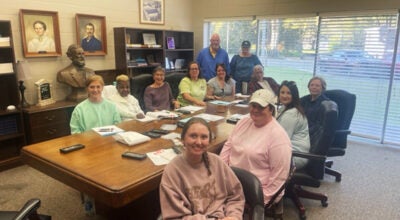
Run for the Roses is this Saturday

School canceled for Prentiss Christian tomorrow; JDC moves to virtual learning due to severe weather threat
Jefferson davis county designated as primary natural disaster area after drought.
- Classifieds
- Small Business
- Submit a News Tip
- Submit a Photo
- Birth Announcement
- Birthday Announcement
- Engagement Announcement
- Wedding Announcement
- © 2024, Prentiss Headlight
VLADIMIR NIKOLAEVICH MEGRE
Author of the series The Ringing Cedars of Russia
Little is known about Vladimir Megre's early background, apart from a few experiences he himself describes in the context of his writings. One of these occurred in the 1960s when over the course of a year the teen-aged Megre made periodic visits (as inconspicuously as possible) to a monk named Father Feodorit at the Trinity-Sergiev Monastery in the town of Sergiev Posad (then known as Zagorsk), just east of Moscow. These meetings (described in Chapter 24 of Book 2, The Ringing Cedars of Russia (pp. 119-31) left a lasting impression on the young Vladimir's consciousness, and can perhaps be taken as a prelude to his later spiritual transformation during his meetings, as he describes them, with Anastasia in the Siberian taiga.
We know that by the mid-1980s Megre was married with a daughter and living in Novosibirsk, where, like many other budding Russian capitalists, he took advantage of perestroika and the subsequent collapse of the communist system to launch into an entrepreneurial career. Even before perestroika he had shown his business acumen in finding ways to significantly increase the profits of a photographic collective. He went on to form a number of commercial co-operatives and by the late 1980s had leased a fleet of river steamers which plied the waters of the Ob River north of Novosibirsk. (see Chapter 1 of Book 1, Anastasia).
On one of these trips north in 1994, he encountered two elderly gentlemen who told him of a cedar tree (kedr in Russian, more commonly known as the Siberian pine in English) deep in the taiga forest that was making a 'ringing' or humming sound, which meant it was near the end of its centuries-old life and was ripe for cutting up and giving out pieces to those interested in its remarkable healing properties. He decided to return to the area the following year (1995) on his own to investigate. In place of the two elderly gentlemen he discovered a young woman in her twenties who said they were her grandfather and great-grandfather, and offered to take him to the cedar they had described. She turned out to be a recluse who lived all alone in the taiga, with no other company or facilities (including housing and food supply) than those provided by Nature.
But that was just the beginning. During the three days Megre spent with her in the taiga, she revealed to him not only the secrets of the ringing cedar, but many mysteries of Nature and the Universe - especially their role in the Divine order of things - that had been known to people in so-called ancient times but subsequently lost to mankind. Much of the earlier knowledge had been deliberately consigned to oblivion by so-called 'wise men' who felt their own sophisticated world-view threatened by the simple wisdom of their forebears.
At his new acquaintance's insistence he reluctantly abandoned his business career and set about writing a book about his taiga experiences (but only after he became penniless trying to set up a league of ethical entrepreneurs and only after his marriage failed, although he received help from a number of Moscow university students as well as his grown daughter Polina). The book, entitled Anastasia, was published in 1996 - largely thanks to the generosity of the manager of a print shop Megre had shown it to - and sold by the author himself in Moscow subway stations.
Then an incredible turn of events suddenly took place. A great number of those who purchased the book returned right after they finished reading it (or even before) to buy copies for their friends and neighbors, and the first print-run of 2,000 copies sold out in a very short time. A generous donor financed the next printing, before a recognized publisher caught wind of its success and launched it into mass production. (The Russian editions of the Ringing Cedars Series are now published by Dilya Publishers in Moscow & St-Petersburg.) And one copy of the first printing even ended up in the United States Library of Congress collection.
The success of Book 1 prompted the author to write a second volume, The Ringing Cedars of Russia, which offers, among other things, a fascinating behind-the-scenes look at the story of how Anastasia came to be published, as well as a deeper exploration of the concepts revealed in the first book. Subsequent visits to Anastasia in the taiga - including conversations with the son she had conceived together with the author - engendered even more books, which now number eight in the original (the last one running into two volumes). By 1999, only three years after the first book appeared, Vladimir Megre had become modern Russia's most widely read author, with his writings selling in the millions.
At the end of Book 3, The Space of Love, may be found a thumbnail sketch of the "Series at a glance", as well as a brief description of the background to the series and profiles of the author, translator and editor.
It is interesting to note the change in the author's style over the course of the books. According to his own admission, before his taiga adventure this hard-nosed businessman had never written a word of prose or poetry before in his life, but he reluctantly launched into writing a book at the insistence of Anastasia. He admits his initial prose did not sound professional, which only aggravated his difficulty in getting his first book to press. This prose may well be described as 'choppy' and simplistic, but over the first few books - under the influence, he says, of Anastasia - his writing gradually developed into a style more and more polished and professional. By the latter part of Book 3, entitled The Space of Love, and throughout a good part of Book 4, Co-creation, his dialogues with the Siberian recluse take on the quality of poetic prose, including elements of met re and even rhyme. These features have been preserved as much as possible in the English translation.
John Woodsworth, Slavic Research Group, University of Ottawa
For more information on the book and their availability in English and other languages, see Publications section of this web-site.
Electrostal History and Art Museum

Most Recent: Reviews ordered by most recent publish date in descending order.
Detailed Reviews: Reviews ordered by recency and descriptiveness of user-identified themes such as wait time, length of visit, general tips, and location information.
Electrostal History and Art Museum - All You Need to Know BEFORE You Go (2024)
- (0.19 mi) Elektrostal Hotel
- (1.21 mi) Yakor Hotel
- (1.27 mi) Mini Hotel Banifatsiy
- (1.18 mi) Elemash
- (1.36 mi) Hotel Djaz
- (0.07 mi) Prima Bolshogo
- (0.13 mi) Makecoffee
- (0.25 mi) Amsterdam Moments
- (0.25 mi) Pechka
- (0.26 mi) Mazhor
Hours of Operation
- The Ups Store #7788
The UPS Store Ennis
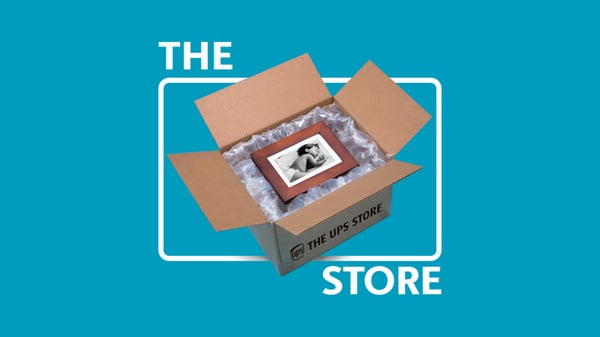
Make Mom’s Day
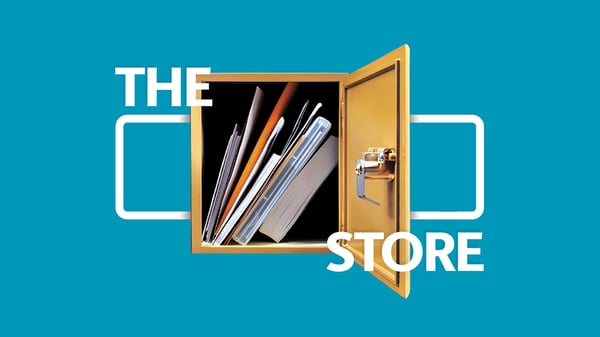
Convenient Mailboxes

Flexible to Fit Your Schedule
Shipping services.

Pack & Ship Guarantee*
We pack it. We ship it. We guarantee it.
Get the benefit of The UPS Store ® Pack & Ship Guarantee.* If a participating The UPS Store location packs your item using only new materials purchased at that location, you'll be reimbursed for the cost of packing and shipping plus the value of your items, if lost or damaged.*
The Pack & Ship Guarantee* offers peace of mind and is only available at participating The UPS Store locations.
* See Full Details

Certified Packing Experts
When it comes to cushioning and protecting your shipments, there's nothing The UPS Store Certified Packing Experts ® can't handle. We are trained in advanced packing techniques and specialize in properly packing fragile, high-value, large and odd-shaped items. If you're looking to ship electronics, artwork, antiques or luggage.
Stop by The UPS Store ® location at 400 I 45 today.

UPS® shipping in Ennis
The UPS Store ® location at 400 I 45 offers a full range of UPS ® shipping services for destinations within the United States.
- UPS Next Day Air ®
- UPS 2nd Day Air ®
- UPS 3 Day Select ®
- UPS ® Ground
Not sure how to pack your shipment? Don't worry, The UPS Store Certified Packing Experts® can take care of that for you so you can stop in and ship out with confidence. Come visit us today!
Products and Services
Printing printing.
- Start Online Print Order
Shipping & Packing Shipping & Packing
- Estimate Shipping Cost
Mailboxes Mailboxes
- Mailbox Services
Additional Services

About The UPS Store The UPS Store Ennis
Areas served, accepted payments.
- American Express
- Google Pay TM
- Apple Pay ®
- Samsung Pay ®
Connect with Us

Store Services
Printing products.
- Business Cards
- Invitations
Printing Services
- Online Printing
- Mobile Printing
- Full Service Digital Printing
- Wide Format Printing
- Color and Black & White Printing and Copying
- Package Acceptance
- Package Receipt Notification
- Mail Forwarding
- Call-in MailCheck
Small Business Services
- Fax Services, Send and Receive
- Printed Marketing & Business Materials
- House Account Program
- Computer Rental
Mailing Services
- Priority Mail®
- Express Mail®
- Parcel Post®
- First Class Mail®
- Global Express Guaranteed®
- Delivery Confirmation™
- Signature Confirmation®
- Certified Mail™ with Return Receipt
- UPS Next Day Air® Early
- UPS Next Day Air®
- UPS Next Day Air Saver®
- UPS 2nd Day Air A.M.®
- UPS 2nd Day Air®
- UPS 3 Day Select®
- UPS International
- UPS My Choice(SM)
Packing Services
- Custom Packaging
- Packaging Boxes & Supplies
- Electronics Packaging
- Ground Freight
Additional Products and Services
- Office Products and Supplies
- Notary Services
Join Our Mailing List
Nearby ups store locations, the ups store waxahachie, the ups store red oak, the ups store kaufman.
- Copies & Documents
- Direct Mail
- Blueprints & Architectural Printing
- Stationery & Cards
- Banner Printing
- Poster Printing
- Sign Printing
- All Printing Services
- UPS Shipping
- Packing & Shipping Boxes
- Postal Services
- International Shipping
- Freight Shipping
- Moving Boxes & Supplies
- Pack & Ship Guarantee
- All Shipping & Packing Services
- House Accounts
- Faxing & Scanning
- Election 2024
- Entertainment
- Newsletters
- Photography
- Personal Finance
- AP Investigations
- AP Buyline Personal Finance
- AP Buyline Shopping
- Press Releases
- Israel-Hamas War
- Russia-Ukraine War
- Global elections
- Asia Pacific
- Latin America
- Middle East
- Election Results
- Delegate Tracker
- AP & Elections
- Auto Racing
- 2024 Paris Olympic Games
- Movie reviews
- Book reviews
- Personal finance
- Financial Markets
- Business Highlights
- Financial wellness
- Artificial Intelligence
- Social Media
The German chancellor presses China on Russia’s invasion of Ukraine
In this photo released by Xinhua News Agency, Chinese President Xi Jinping, second from left, and German Chancellor Olaf Scholz, second from right, walk together in Beijing, China, on Tuesday, April 16, 2024. (Ding Haitao/Xinhua via AP)
In this photo released by Xinhua News Agency, Chinese President Xi Jinping, right and German Chancellor Olaf Scholz pose for a photo at the Diaoyutai State Guesthouse in Beijing, China, on Tuesday, April 16, 2024. (Xie Huanchi/Xinhua via AP)
German Chancellor Olaf Scholz speaks during a press conference in Beijing, China, Tuesday, April 16, 2024. German Chancellor Olaf Scholz is on a 3 day visit to China. (Andres Martinez Casares, Pool Photo via AP)
In this photo released by Xinhua News Agency, Chinese President Xi Jinping, right and German Chancellor Olaf Scholz pose for a photo in Beijing, China, on Tuesday, April 16, 2024. (Xie Huanchi/Xinhua via AP)
- Copy Link copied
BEIJING (AP) — German Chancellor Olaf Scholz said he asked Chinese leader Xi Jinping on Tuesday to pressure Russia to end its “insane campaign” in Ukraine, the latest in a parade of European leaders and senior officials to make such an appeal.
The Chinese side gave no sign of any change in its position, which has been to blame Europe and the U.S. for prolonging the fighting by supplying Ukraine with weapons and calling for peace negotiations that recognize Russian as well as Ukrainian concerns.
“China is not a party to the Ukraine crisis but has consistently promoted talks for peace in its own way,” read a Chinese statement following talks between Xi and Scholz in the Chinese capital.
Scholz, winding up a three-day visit to China, told journalists that he believes “a building block has been put in place” that will contribute to discussions on diplomatic efforts to end the war .
Earlier, he said in a post on the social media platform X that he had asked Xi to use his influence with Russia.
“China’s word carries weight in Russia. So I asked President Xi to bear upon Russia so that Putin finally breaks off his insane campaign, withdraws his troops and ends this terrible war,” he wrote.
China has broken with the West in refusing to criticize Russia’s invasion. While the government says it is not sending military aid to Moscow, it has provided an economic lifeline by growing trade with Russia, helping it cope with Western sanctions. A U.S. intelligence report last week found Beijing has increased equipment sales to Moscow to indirectly boost its war effort against Ukraine.
Scholz said the talks had addressed China’s exports of so-called dual-use goods, which can have both civilian and military purposes.
“There is an absolute insistence that there be no weapons exports, but the question of dual-use also must not be ignored,” he said. “And it was possible to bring up everything that is necessary here in a way that it can’t be misunderstood.”
Scholz also said the use of nuclear weapons should not even be threatened, according to a German government transcript of his remarks at the start of the meeting with Xi.
Russian President Vladimir Putin warned last month that his government is ready to use nuclear weapons if its sovereignty or independence is threatened, his latest such threat since invading Ukraine.
A Chinese statement said the two leaders noted that China and Germany stand committed to the U.N. Charter and oppose the use of nuclear weapons.
“China encourages and supports all efforts that are conducive to the peaceful resolution of the crisis, and supports the holding in due course of an international peace conference that is recognized by both Russia and Ukraine and ensures the equal participation of all parties and fair discussions on all peace plans,” the Chinese statement said.
On trade, Xi told Scholz that their two countries should stay vigilant against the rise of protectionism and take an objective view of the issue of manufacturing capacity, according to the statement.
The German leader’s visit has underscored trade-related tensions as the European Union and the United States complain that China is competing unfairly through the use of subsidies that have created massive production capacity, particularly for solar panels, electric cars and other green-energy products.
The EU is mulling tariffs to protect its producers against cheaper Chinese electrical vehicle imports , which some fear will flood the European market.
Scholz, meeting separately with Chinese Premier Li Qiang, called for concrete improvements in several areas for German companies operating in China, including market access, fair competition, intellectual property protection and the legal system.
“In order for these companies to be able to continue doing so, they need the right conditions,” he said.
Despite the political and trade frictions, China was Germany’s top trading partner for the eighth straight year in 2023, with 254.1 billion euros ($271 billion) in goods and services exchanged between the sides, slightly more than what Germany traded with the U.S. but a 15.5% contraction from the year before.
This is Scholz’s second trip to China since he became chancellor in late 2021. It is his first visit since the German government last year presented its China strategy, which met with criticism from Beijing . Li, the Chinese premier, visited Berlin in June.
Associated Press writers Geir Moulson in Berlin and Christopher Bodeen in Taipei, Taiwan, contributed to this report.

An official website of the United States government
Here's how you know
Official websites use .gov A .gov website belongs to an official government organization in the United States.
Secure .gov websites use HTTPS A lock ( Lock Locked padlock ) or https:// means you’ve safely connected to the .gov website. Share sensitive information only on official, secure websites.

Principal Deputy Assistant Secretary Mooney Highlights Wildfire Resilience Funding, Native Seed Supply from President Biden’s Investing in America Agenda During Georgia Visit
Date: Thursday, April 18, 2024 Contact: [email protected]
ATHENS, Ga. — Principal Deputy Assistant Secretary for Policy, Management and Budget Joan Mooney was in Georgia today to highlight how President Biden’s Investing in America agenda is supporting wildland fire management.
During a visit to the State Botanical Garden of Georgia at the University of Georgia, Principal Deputy Assistant Secretary Mooney highlighted the collaborative partnership between the Botanical Garden, the Department’s U.S. Fish and Wildlife Service, the Southeastern Grasslands Institute, and the U.S. Department of Agriculture, which is establishing the Georgia Native Seed Network to produce locally adapted seeds and other plant materials across much of the Southeast.
Much of the Southeast lacks an adequate supply of genetically appropriate seeds and plants materials, which can hinder wildfire recovery and habitat restoration efforts. The solutions created through this collaborative partnership will be used to meet future wildfire recovery and other land management needs while minimizing cost, creating jobs, and bolstering the native plant industry in the private sector. Principal Deputy Assistant Secretary Mooney was briefed on seed collecting and processing and how the Georgia Native Seed Network is growing the plants from seed. These efforts build on the Department’s National Native Seed Strategy Keystone Initiative , focused on securing enough native seeds and plants to restore lands impacted by wildlife and other climate impacts.
Principal Deputy Assistant Secretary Mooney also highlighted the Department’s recent announcement of $79 million to expand wildfire detection capabilities, reduce risk from wildfires, help rehabilitate burned areas and enhance radios and other technology used by wildfire incident management teams. She discussed with stakeholders how $44 million from that investment will help to develop locally adapted seeds and plant materials to revegetate areas that are so severely impacted by wildfires that the lands are unlikely to recover naturally.
These wildland fire investments build on more than $780 million previously allocated by the Interior Department under the Bipartisan Infrastructure Law since it went into effect in fiscal year 2022. Through the President’s Bipartisan Infrastructure Law, the Department is investing $1.5 billion over five years to better support its wildland firefighting workforce and increase the resilience of communities and lands facing the threat of wildfires. These critical investments, along with accompanying funding for the U.S. Department of Agriculture, are supporting the nation’s wildland fire workforce, accelerating the pace and scale of fuels management and burned area rehabilitation, and advancing wildland fire science. These investments will promote more accurate wildfire risk assessments and mitigation, faster wildfire identification and strategic responses, and responses that are both safer and more effective.
Visit the Department’s interactive map to track funding invested so far from the Bipartisan Infrastructure Law across thousands of projects nationwide.

Acting Deputy Secretary Daniel-Davis Highlights President’s Investing in America Agenda in Puerto…

Biden-Harris Administration Announces $79 Million from President Biden’s Investing in America…

Secretary Haaland Highlights Conservation Efforts, Wildfire Prevention Investments, During Visit to…
Was this page helpful.
This page was not helpful because the content:
Please provide a comment

IMAGES
VIDEO
COMMENTS
The printing press is a device that allows for the mass production of uniform printed matter, mainly text in the form of books, pamphlets and newspapers. Created in China, the printing press ...
A printing press is a mechanical device for applying pressure to an inked surface resting upon a print medium (such as paper or cloth), thereby transferring the ink.It marked a dramatic improvement on earlier printing methods in which the cloth, paper, or other medium was brushed or rubbed repeatedly to achieve the transfer of ink and accelerated the process.
Printing presses push paper against inked movable type materials to transfer text and images from the type onto the paper. Medieval presses used a handle to turn a wooden screw that moved the platen on which the paper was mounted; the platen squeezed the paper against the type, which was locked in place in a frame, or form. Metal presses, developed late in the 18th century, used steam to drive ...
Our Gutenberg Press is a replica that was created specifically for the Museum in the 1990s. Its design is based on woodcuts from the 15th and 16th Century, such as the "Danse Macabre.". It is also very similar to a press that can be found at The Gutenberg Museum in Mainz, Germany. Museum Founder Ernie Lindner tediously, and somewhat ...
There are some inventions that have changed the course of human history, and the printing press is one of them. As the name suggests, this machine allows for the mass production of printed matter like newspapers and books. Its function sounds unremarkable today, but when the printing press was refined by Johannes Gutenberg in the 15th century ...
The Museum's Book Arts Tour is a visual journey through the graphic world of printing, paper, books and images using the world renowned collections of the Printing Museum. Your two-hour tour begins with the Chinese invention of paper and printing and continues on the the invention of the Printing Press and Gutenberg Bible.
Stephen Fry takes a look inside the story of Johann Gutenberg, inventor of the world's first printing press in the 15th century, and an exploration of how and why the machine was invented.
Minhal Gardezi, a PhD student in physics at the University of Wisconsin Madison, says that the ultimate goal is to see if they can get traces of the printing press itself. "We can compare that ...
During your guided tour, you will learn of early forms of printing, may participate in the hands-on printing of a leaf of the Gutenberg Bible pulled from a replica press, print a copy of the Declaration of Independence on a 19th-century Columbian iron handpress, discover the importance of the Linotype machine, and witness advances in printing and self-publishing that came about in the 20 th ...
The printing press is a useful tool for communicating and disseminating ideas on paper quickly and at a large scale. Before the advent of radio, television, the Internet, and other forms of mass media, printed materials (such as treatises, books, bulletins, newspapers, and magazines) were used to share ideas quickly and efficiently for the purposes of informing large numbers of people about ...
The Museum is home to one of largest collections of printing equipment and supporting materials in the world. Its major collections include the Ernest A. Lindner Collection of Antique Printing Machinery and artifacts from two prominent California printing companies, the Colby Printing Co. and Earl Hayes Press. The Museum also has an extensive ...
In early April of 2021, Mark happened to be on a trip to New York to install a press for a film shoot. The South Street Seaport Museum and the International Printing Museum have had an open dialogue for many years, but being on opposite coasts, it's a rare treat to be able to physically visit each other's collections.
The Hatch Show Print tour is a sensory and educational experience on moveable type, letterpress printing and Nashville's story as Music City. Take the tour of Hatch Show Print and learn all about the history of this iconic letterpress poster shop. Listen to the presses run.
Minuteman Press International was once again rated the #1 Printing Franchise in the printing industry by Entrepreneur Magazine (January 2024). This is the 33 rd time overall and 21 st straight year that we have achieved this stellar rating. Interested in franchise opportunities? Learn more about how to become a Minuteman Press franchise owner.
Description. King Fahd Glorious Quran Printing Complex is a printing press in Medina. This complex exclusively prints more than 10 million copies of the Holy Quran every year. These prints are not just in the Arabic language but also include translations in languages such as English, Indonesian, Russian, Japanese, Persian, Urdu, Bengali, Korean ...
U.S. Press offers the best of both worlds to become the commercial printing company of your dreams. We make your advertising printing choice easy by offering: High Quality Commercial Printing - With over 42 years of experience, we're the experts in print marketing. Request a free sample kit to see the difference in our professional printing.
We offer the broadest digital printing press portfolio of cut-sheet digital presses and production printers on the market. Sheet-fed digital printing presses are ideal for graphic communications and commercial print providers' high-speed, high-volume printing applications, including publishing, transaction printing, direct mail, packaging and photo publishing.
A tour was given of the sales, graphics and news departments with the final stop at the printing press. Press operator Malcolm Stewart was setting up to print the Daily Leader. (The Headlight is printed at 7:30 a.m. on Wednesday mornings, so scheduling did not allow for them to see it printed.)
Humble Heart Press. As a homeschooling family, we at Humble Heart Press are passionate about serving the homeschool community. We are dedicated to printing and binding affordable, high-quality homeschool materials, including planners, curriculum, notebooks, teacher manuals, flashcards, maps and other resources.
And one copy of the first printing even ended up in the United States Library of Congress collection. The success of Book 1 prompted the author to write a second volume, The Ringing Cedars of Russia, which offers, among other things, a fascinating behind-the-scenes look at the story of how Anastasia came to be published, as well as a deeper ...
Most Recent: Reviews ordered by most recent publish date in descending order. Detailed Reviews: Reviews ordered by recency and descriptiveness of user-identified themes such as wait time, length of visit, general tips, and location information.
Ennis, TX 75119. (469) 456-0062. (469) 456-0018. [email protected]. Estimate Shipping Cost. Contact Us. Get directions, store hours & UPS pickup times. If you need printing, shipping, shredding, or mailbox services, visit us at 400 I 45.
Business, Economics, and Finance. GameStop Moderna Pfizer Johnson & Johnson AstraZeneca Walgreens Best Buy Novavax SpaceX Tesla. Crypto
JSC "Elektrostal Heavy Machine Building Plant". Stand N5730. Metal-Expo'2005, the 11th International Specialized Exhibition
The German leader's visit has underscored trade-related tensions as the European Union and the United States complain that China is competing unfairly through the use of subsidies that have created massive production capacity, particularly for solar panels, electric cars and other green-energy products.. The EU is mulling tariffs to protect its producers against cheaper Chinese electrical ...
Date: Thursday, April 18, 2024 Contact: [email protected] ATHENS, Ga. — Principal Deputy Assistant Secretary for Policy, Management and Budget Joan Mooney was in Georgia today to highlight how President Biden's Investing in America agenda is supporting wildland fire management. During a visit to the State Botanical Garden of Georgia at the University of Georgia, Principal Deputy ...
April 18, 2024. Gov. Kemp Signs Historic Tax Cut Package Into Law. Augusta, GA - Governor Brian P. Kemp, accompanied by First Lady Marty Kemp, Members of the General Assembly, and local and state leaders, signed HB 1015 into law today at a ceremony in Augusta - accelerating the largest state income tax cut in Georgia history.